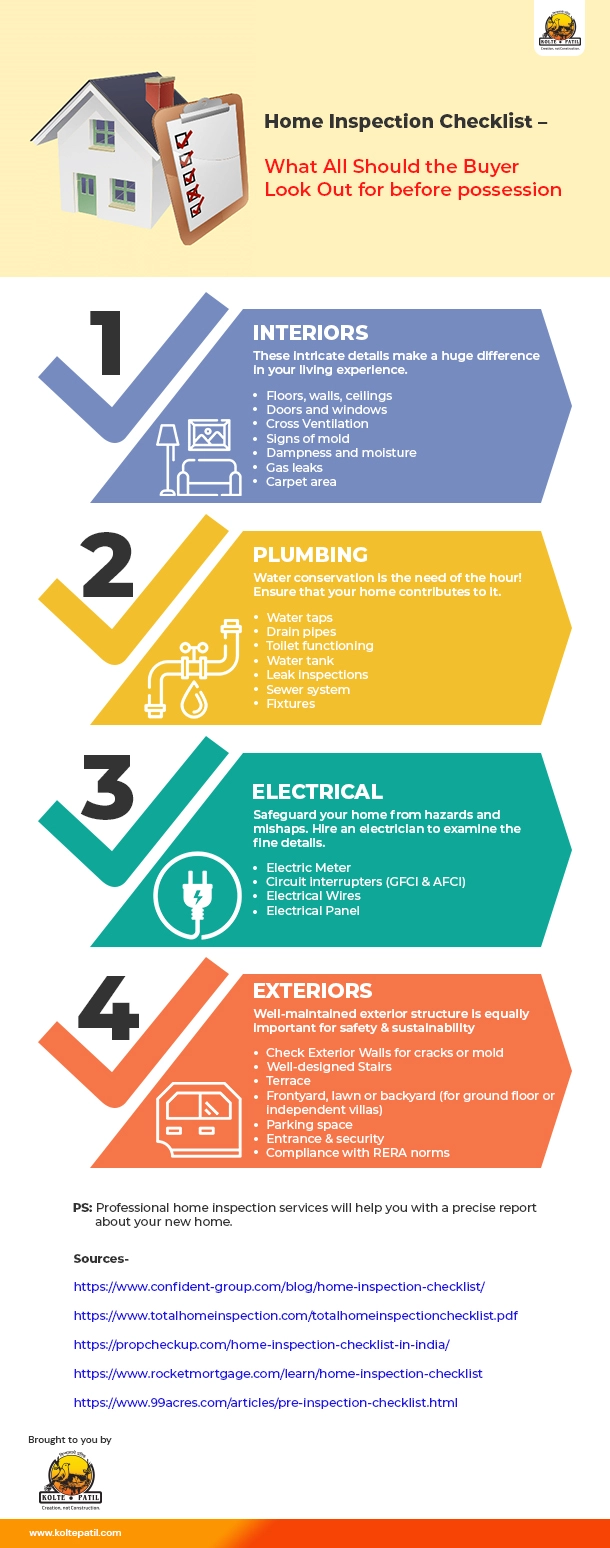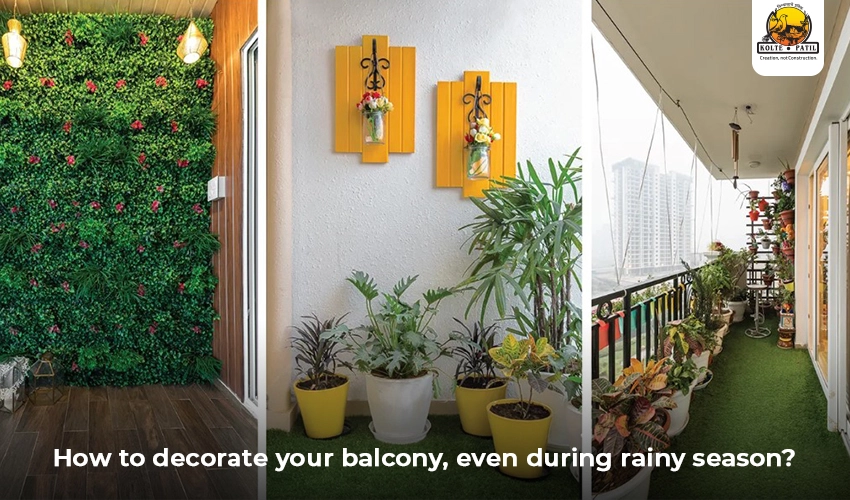
Home Inspection Checklist – What All Should the Buyer Look Out for before possession
Buying a home is not just a monetary investment but also an underwriting for a secured future for your family. To ensure an informed decision, here is a curated list of what to expect from home inspection as a buyer.

Click on Image to View Larger
1. Interiors
The physical attributes of the interiors require comprehensive assessment; hence we have a how to prepare for home inspection checklist:
Floors, walls, ceilings
- Levelling off the floor—The easiest method is to get any spherical object and see if it stays or rolls onto another end. A more professional assessment requires:
| Use 4–6-foot beam level on your floor. Check the inclination of the bubble on either side of the spectrum. Laser-level equipment is another solution for how to do a home inspection yourself. There are also phone-level apps for quick checking |
- Check for stains on floors, walls, and ceilings.
- Any signs of cracks in the ceilings and walls should be recorded immediately. Wall-to-wall home inspections are crucial for safety precautions.
- Note down any paint faults or misses.
- Ensure the false ceiling is installed perfectly without cracks or hanging electrical wires.
Doors and windows
- Ensure that the doors and windows lock/unlock smoothly. If there are children at home, child-proof the latches.
- Forquestions to ask during home inspections, enquire whether the window panels have used storm windows or thermal glass.
- There should be no broken double-paned, insulated window seals or damaged screens.
Cross Ventilation
Make sure that the window placement allows ample airflow and allows cross ventilation.
Signs of mould
Moulds can manifest in vast areas while damaging your wooden furniture and fabrics. On how to inspect a home for moulds, look for these three areas:
- Areas prone to leakages.
- Spots with no air-circulation, viz. Behind the wardrobes, storage area etc.
- The area surrounding the windows is likely to have condensation build-up, leading to mould.
Dampness and moisture
Speaking of moulds, inspect the area with unnecessary dampness. These are early signs of leakages and may lead to health problems. Moreover, the moisture-soaking walls might lead to paint peeling later.
Gas leaks
Hack: soapy water test– Take a teaspoon of dish detergent with a cup of water. Now apply it to the surface where you suspect a gas leak. The bubbles forming indicate escaping gas.
Precision: For a more accurate solution on how to do a home inspection, use natural gas leak detector.
Carpet area
This requires professional help to verify the carpet area as per RERA standards.
2. Plumbing
Water taps & Fixtures
Check for the end-to-end functioning fixtures. There should be adequate flow and pressure in all taps. All faucets open and close without any water leakage.
Drainpipes
Clogged outlet pipes can lead to increased water pressure, bursting the lines in the long run. Check the sink flow and assess for any prolonged water clogging. Also, check for any foul odour– it can signify ineffective drainage.
Toilet functioning
Make sure that there are no flush issues. Check out the caulking besides the commode; there should ideally be no cracks or leakage through it.
Leak inspections
Water seepage is common in washroom ceilings and around kitchen sinks. However, these are easier to detect— if you spot any bulging areas on the ceiling surface, it indicates water seepage, which may lead to full-blown leakage.
Sewer system
Frequent sewer management is mandatory. Sewer system inspection reports give you an estimation of the functioning of the entire building. For this assessment, you can seek help from the co-op housing society of your apartment complex.
3. Electrical
Switches and outlets
Verify whether every switch works in the house. You can also request an extra outlet if needed.
Appliances
Try a few of your electrical appliances. Ensure that the installed lightings and ceiling fan operate in accordance with the switches. Check for any sparks in the panel.
Circuit interrupters (GFCI & AFCI)
Ask your local electrical to assess these interrupters, ensuring there is no current overload in your apartment.
Electrical Wires
Make sure that top-quality wires are installed with double insulation.
Electrical Panel
For this, consult with your local electrician to verify the proper wiring. Note down any faulty circuit that may lead to power failure. You may experience a burning smell.
4. Exteriors
Exterior Walls
Another aspect of what to look for in a home inspection checklist is the exterior structure of the building. Make sure there are no cracks on the edges of your apartment. Also, report any signs of mould.
Stairs, fire security, and elevators
Even a small outbreak can affect the entire building. It is better to check the efficiency of evacuation measures.
Terrace, Frontyard, lawn or backyard
If you are living on the ground floor, ensure your contract includes the maintenance service of the lawn space around your apartment. Also, check if the terrace is flood-proof.
Entrance & Security
Digital security measures with the monitored entrance are the best way to ensure safety.
Compliance with RERA norms
The OC (occupancy) and CC (completion) certificates ensure that the building is in proper order and compliance with the set standards.
PS: Professional home inspection services will help you with an accurate report.
If you are looking for a trusted home with the best facilities, then Kolte-Patil developers have introduced the most befitting apartments in Pune with an assurance of safety and welfare.
FAQs
Q1: Can I do the home inspection myself?
A: Yes, for specific parameters. However, professional services are best for technical evaluation.
Q2: Can the report be submitted officially in case of legal issues?
A: If you hired a professional home inspection, these reports are viable evidence.
Q3: Can I ask for a home inspection before applying for a loan?
A: Yes, you can ask the developer/builder for a thorough inspection.
Q4: What isn’t included in a home inspection service?
A: following are not included
- low-wattage electrical features
- Radon inspection/ air-borne hazards
- Inaccessible areas
- Pest control- infestation
- Landscaping
Sources-
https://www.confident-group.com/blog/home-inspection-checklist/
https://www.totalhomeinspection.com/totalhomeinspectionchecklist.pdf
https://propcheckup.com/home-inspection-checklist-in-india
https://www.rocketmortgage.com/learn/home-inspection-checklist
https://www.99acres.com/articles/pre-inspection-checklist.html




